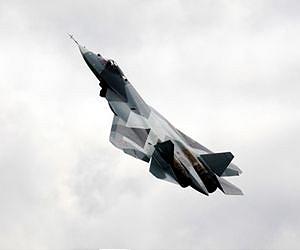.
Russia's largest radio electronics manufacturer gave a glimpse into the future of Russian air superiority confirming on Monday that components for a sixth 6th generation fighter jet are being tested on the 5th generation PAK FA T-50 prototype.
Russia has begun testing hardware elements designed for a future 6th generation fighter jet, heralded as the first combat aircraft that will be able to engage targets from near space, on a 5th generation prototype that is currently undergoing flight trials according to a TASS news agency report.
Vladimir Mikheyev, advisor to the First Deputy Director General of Concern Radio Electronic Technologies (KRET), a subsidiary of Russian Technologies State Corporation (Rostec), revealed that various components of the new jet have been tested on the Sukhoi PAK FA (Prospective Airborne Complex Frontline Aviation) T-50 prototype.
"Standalone solutions that will be applied in the sixth-generation fighter are now being tested on the fifth-generation jet as well as on the ground-based equipment. Separate elements of the flight and navigation system have already been installed on PAK FA," Mikheyev told TASS news.
The PAK FA is a 5th generation multi-role, single seat, twin-engine air superiority/deep air support fighter slated to enter service in the Russian Air and Space Forces in 2018. It also serves as the prototype for the joint Indo-Russian Sukhoi/HAL Fifth Generation Fighter Aircraft (FGFA) project that has tormented the US military and industrial complex that now fears New Delhi will look to Moscow for its weapons procurement needs.
The sixth generation fighter jets planned to be unveiled by 2025 will consist primarily of swarms of unmanned aircrafts flying at hypersonic speed with developers saying that the jets would be able to transit through space.
The aircrafts will be equipped with electromagnetic cannons - much like the Navy's railgun - which can force an enemy's radio detector out of operation at a 10km range. The super-high frequency weapons is so powerful, however, that it will not be installed on piloted aircrafts as it can harm the pilot.
"In particular, the electromagnetic impulse, with which the SHF's weapon will be hitting the targets, will be so powerful that it will be extremely difficult to protect a human, a pilot from his own weaponry," explained Mikheyev.
The sixth-generation fighter jet has not yet been commissioned by Russia's Defense Ministry, but there are hopes to finish the research and development part of the work until 2020 so that KRET can produce the first sixth generation aircraft by 2025 upon the ministry's order.
---
Stealth ability neutralized as Russia's T-50 jet fighter to rule the skies

Sukhoi PAK FA fighter jet, also known as T-50.
An active defense system developed for Russia's fifth-generation T-50 jetfighter is also able to neutralize enemy planes' stealth capability, RIA Novosti reported Friday, citing the press service of the Himalaya system's designers, the Radioelectronic Technologies Concern [KRET].
The Sukhoi PAK FA fighter jet, also known as T-50, is ready to go into production next year, and boasts innovative technology which renders the pilot one part of the plane's control system.
"The PAK FA is already to some degree a flying robot, where the aviator fulfils the function not only of pilot, but is actually one of the constituent parts of the flying apparatus," explained Vladimir Mikheyev, deputy head of KRET, which is a unit of Rostech Corporation.
The use of composite materials, innovative technologies, advanced avionics and engines ensure the T-50's extremely low level of radar, optical and infrared visibility.
At present the US is the only country to have operational fifth-generation aircraft - the F22 Raptor and F35 Lightning II.
KRET has also created for the T-50 the upgraded BINS-SP2M strapdown inertial navigation system that autonomously processes navigation and flight information, determines position and motion parameters in the absence of satellite navigation, and can integrate with GLONASS, Russia's space-based satellite navigation system.
The T-50 is set to replace the Sukhoi Su-27 fourth generation fighter jet, which entered service with the Soviet Air Force in 1985, and the Mig-29, which entered service in 1983.
In December 2014 Russia's United Aircraft Corporation announced that production of the fighter was ready to begin in 2016, following the completion of the testing phase.
55 PAK FA jets will be delivered to the Russian Air Force by 2020.
---
Russian MoD Denies Plans for Nuclear-Capable Outer Space Strategic Bomber
-
According to the Russian Defense Ministry, military educational institutions don't have the competence to deal with such projects.
Reports claiming that the Russian Strategic Missile Forces Academy is developing a hypersonic nuclear-capable outer space strategic bomber are not true, a representative of the Russian Defense Ministry told reporters Thursday.
"Advanced engines for space exploration has been continuously developed in Russia since the middle of the last century.
"However, there are no plans to create [outer] space strategic bombers in the Russian Strategic Missile Forces Academy in Serpukhov. Military educational institutions of the Russian Defense Ministry don't have the competence to deal with such projects," the representative said.
On Wednesday, a developer from the academy, Lt. Col. Aleksei Solodovnikov told RIA Novosti that Russia was developing a hypersonic strategic bomber capable of striking nuclear blows from outer space.
Quelle: SD
3897 Views

